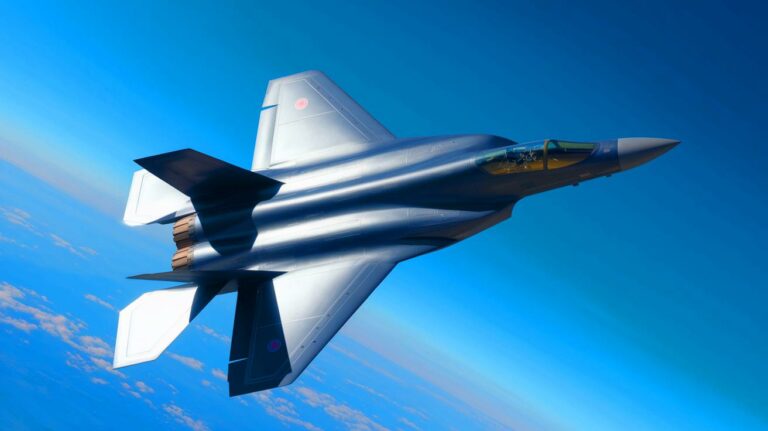| IN A NUTSHELL |
|
The rise of China in the sphere of military technology has captured global attention. Among its latest innovations is a new generation tailless fighter jet that stands out not only due to its advanced technological features but also its potential strategic implications. As major world powers strive to bolster their military arsenals, China seems to have made a significant leap forward. This article delves into the specifics of this new jet, its unique features, and what it signifies for the future of military aviation.
Tailless Design: A Revolutionary Innovation
The Chengdu J-36 is a versatile fighter developed by China to meet modern military aviation needs. Combining performance and advanced technology, this aircraft marks a significant step in the evolution of Chinese military aviation. The most remarkable feature of this fighter jet is its lack of a tail. This innovation is not merely for aesthetics; it holds major implications for the aircraft’s performance. By eliminating the tail, Chinese engineers have managed to reduce aerodynamic drag, thereby enhancing the aircraft’s efficiency and speed. This could enable it to surpass the maximum speeds achieved by conventional fighters.
Furthermore, the absence of a tail simplifies the aircraft’s structure, potentially reducing production and maintenance costs. The savings could then be reinvested in other critical areas such as weaponry or detection systems. However, this design also presents challenges, particularly regarding stability and control, which must be overcome using advanced technologies such as fly-by-wire control systems. This innovation might inspire new approaches in military aircraft design worldwide, prompting other nations to rethink their military aviation strategies. Ultimately, the tailless design could become the standard for future fighter jets, marking a departure from traditional designs.
Stealth Technology: A Step Toward Invisibility
Stealth is a crucial aspect of military aviation, and this Chinese fighter jet is no exception. By incorporating cutting-edge technologies, this new aircraft aims to minimize its radar signature. This makes it virtually invisible to enemy defense systems, providing an undeniable strategic advantage. The materials used in the construction of this jet play an essential role in its ability to evade radar detection. Advanced composites and special coatings are employed to absorb radar signals, thereby minimizing detection. Additionally, the aircraft’s shape is designed to diffuse radar waves, preventing them from returning to the emitter.
This stealth technology is not limited to radar; efforts are also made to reduce the thermal and acoustic signature of the jet, making it difficult to detect even by infrared and sonar systems. The integration of these stealth technologies could represent a turning point in modern warfare, where the ability to avoid detection often equates to survival and success.
Performance and Combat Capabilities
The Chengdu J-36 is a Chinese multirole fighter designed to ensure air superiority and ground attack missions. With its exceptional performance and advanced technology, it represents a significant advancement in modern military aviation. Beyond its innovative design, this fighter jet also excels in terms of performance. It is designed to achieve high speeds, with the capability to reach impressive altitudes while maintaining exceptional agility. These characteristics make it a formidable adversary on the battlefield.
A portion of these performances can be attributed to its next-generation engine, which combines power and efficiency. This engine allows the jet to maintain high speeds over long distances while optimizing fuel consumption. This combination is essential for military operations, where endurance and speed can mean the difference between success and failure. In terms of armament, the jet is equipped with the latest missile and defense system technologies. These systems are integrated to maximize efficiency while minimizing payload, allowing the jet to maintain its speed and agility. This ability to combine speed, power, and agility makes it particularly suitable for air superiority missions.
Strategic Implications for China and the World
The development of this fighter jet represents a significant milestone for China on the global stage. By demonstrating its ability to design and produce such an aircraft, China sends a strong message to potential adversaries. This new jet could alter the balance of military forces in key regions, notably in the Asia-Pacific. For other major powers, this technological advancement could raise concerns about the need to modernize their own air forces. The arms race could intensify, with increased investments in research and development to rival China’s emerging capabilities.
From a geopolitical perspective, this jet could enhance China’s position in international negotiations, providing an additional leverage point in defense and security discussions. For potential allies, this advancement could also represent an opportunity for collaboration, while for adversaries, it might be perceived as a growing threat. The innovation in Chinese fighter aviation could have a considerable impact on the global aerospace industry. Will other nations rise to the challenge and innovate to maintain their standing on the international stage?
Did you like it? 4.5/5 (27)










Amazing breakthrough! How does the tailless design affect its maneuverability? 🚀
Wow, China is really stepping up their game in military tech. Any word on the cost of this new jet?
Is it just me or does “tailless” sound like they forgot something? 😂
Me confused too. Sure looks like it has a TAIL.
Thanks for the article! How does this compare to the latest American fighter jets?
Stealth technology is incredible. Is it really that invisible to radar?
Should the U.S. be worried about this new development in Chinese aviation?
I hope they aren’t still planning on invading Tiawan in 2027 if this and some ships is all they got lol.thats tech the U.S had over 45 years ago it would be foolish to position the u.S in manner that forces a display of what we have learned in these years.
Interesting read. But I wonder how it handles in a dogfight without a tail?
How soon until we see this in action? 🤔
Alannirvana9,
As soon as you declare a war with china’s plaaf maybe you can watch it in”live mode”…
LMAO. 😁😁😁🤣🤣🤣
Is this a sign that we need to increase our defense budget?
Hardly. Folks in 3000 years China has attacked no one. Few skirmishes over Taiwan. Bit like OZ wanting to retain Tasmania.
China has indeed not invaded any country for 3,000 years, but it has never stopped fighting, including with the Americans!
Great article! But what about the pilot’s visibility in a tailless design?
It’s impressive, but let’s not forget about pilot skill over machine tech. 😎
Can it really shift the geopolitical balance, or is that just hype?
As a taxpayer, should I be concerned about the U.S. falling behind?
Nope, not at all. These Chinese “breakthroughs” are still inferior to America’s F-22 & F-35. That doesn’t even take into account our fighter pilots superior skill sets. You can still rest easy at night
Are there any known weaknesses in this new design?
I bet Elon Musk has some thoughts on this! 😂
How does this innovation impact global arms treaties?
Do we know the production numbers or is it all still hush-hush?
What about the environmental impact of its next-gen engine?
Sounds like a game-changer! But how reliable is the stealth tech in real combat?
Is this the beginning of a new arms race? 😬
The design seems futuristic! Is it based on any current models or entirely new?
Is there any chance this tech could be used for civilian purposes?
Why am I picturing a flying saucer when they say tailless? 👽
How does the maintenance compare to traditional fighter jets?
Incredible. But how does this affect international relations in the Asia-Pacific region?
Does this mean the end of the traditional fighter jet design?
Stealth and power in one package? Sounds too good to be true!
Can this tech be reverse-engineered by other countries? 🤔
I wonder how this will influence the global aerospace industry.
As an aviation enthusiast, this makes me excited for the future! ✈️
China’s innovation is impressive, but can they mass-produce it?
Do other countries have similar projects in the works?
Does this mean more budget for military R&D worldwide?
What do you think about the potential collaboration between China and other countries on this tech?
This is cool and all, but when do we get flying cars? 😂
Me confused too. Sure looks like it has a TAIL.
The picture is not J-36. Very misleading.